ʻĀina Momona, Honua Au Loli—Productive Lands, Changing World: Using the Hawaiian Footprint to Inform Biocultural Restoration and Future Sustainability in Hawai‘i
Abstract
:1. Introduction
E Kāne-au-loli-ka-honuaHonu ne‘e pū ka ‘āina
O Kāne-who-transforms-the-worldLike a sea-turtle crawling, so the land (changes)
1.1. The Rich Ecological Setting in the Hawaiian Islands
1.2. The Current Loss of Major Terrestrial Native Habitats in Hawai‘i
2. Materials and Methods
Mapping of the Human Land Use Footprint in Pre-Contact Hawai‘i
3. Results
4. Discussion
4.1. The Hawaiian Social-Ecological System As a Model of Sustainability and Self-Sufficiency
4.2. Using Pre-Contact Models of Sustainability in Transformed Landscapes
4.3. Post-Contact Changes to the Social-Ecological Landscape of Hawai‘i
4.4. Non-Native Species
4.5. Climate Change
4.6. Diversification
5. Conclusions
Author Contributions
Funding
Acknowledgments
Conflicts of Interest
Appendix A
| Hawaiian Name | Biocultural Relationship | Status | Scientific Name |
|---|---|---|---|
| kou | wood, lei | Polynesian introduction | Cordia subcordata |
| kamani | lei, wood | Polynesian introduction | Calophyllum inophyllum |
| ‘uala | staple crop | Polynesian introduction | Ipomoea batatas |
| ipu | containers, music | Polynesian introduction | Lagenaria siceraria |
| kukui | oil, medicinal, wood, lei, relish, dye | Polynesian introduction | Aleurites moluccana |
| ‘auhuhu | fish poison | Polynesian introduction | Tephrosia purpurea |
| ‘ulu | staple food crop, medicinal, sap, wood | Polynesian introduction | Artocarpus altilis |
| wauke | fiber, clothing | Polynesian introduction | Broussonetia papyrifera |
| ‘ōhi‘a ‘ai | fruit | Polynesian introduction | Syzygium malaccense |
| ‘awa | ritual drink, medicinal | Polynesian introduction | Piper methysticum |
| noni | medicinal, dye | Polynesian introduction | Morinda citrifolia |
| kī | food, medicinal, ritual | Polynesian introduction | Cordyline fruticosa |
| ‘ape | famine food | Polynesian introduction | Alocasia macrorrhiza |
| kalo | mainstay food crop | Polynesian introduction | Colocasia esculenta |
| niu | food, wood, fiber | Polynesian introduction | Cocos nucifera |
| uhi | secondary crop, not naturalized | Polynesian introduction | Dioscorea alata |
| hoi | famine food, naturalized | Polynesian introduction | Dioscorea bulbifera |
| pi‘a | famine food, naturalized | Polynesian introduction | Dioscorea pentaphylla |
| mai‘a hē‘ī | wild food source | Polynesian introduction | Musa troglodytarum |
| mai‘a (varieties) | staple crop | Polynesian introduction | Musa x paradisiaca |
| kō | food | Polynesian introduction | Saccharum officinarum |
| pia | food | Polynesian introduction | Tacca leontopetaloides |
| ‘ōlena | dye, medicinal, ritual | Polynesian introduction | Curcuma longa |
| ‘awapuhi | medicinal | Polynesian introduction | Zingiber zerumbet |
| pā‘ihi‘ihi | uncommon medicinal, accidental? | Polynesian introduction? | Rorippa sarmentosa |
| kāmole | wetland, accidental w/kalo? | Polynesian introduction? | Ludwigia octovalvis |
| ‘ihi | medicinal; indig? seeds in pre-contact sites | Polynesian introduction? | Oxalis corniculata |
| --- | cultiv. central Pac, 3 records from HI | Polynesian introduction? | Solanum viride |
| ‘ohe Kahiki | tools, wood, music, container; indig? | Polynesian introduction? | Schizostachyum glaucifolium |
| --- | seeds in pre-contact sites; indig NA, SA | naturalized? | Daucus pusillus |
| pohe | indig NA; pre 1871 HI records | naturalized? | Hydrocotyle verticillata |
| koali ‘ai | famine food, poss indig? | naturalized? | Ipomoea cairica |
| koali kuahulu | pantropical, indig? | naturalized? | Merremia aegyptia |
| kākalaioa | indig/early intro; also hihikolo | naturalized? | Caesalpinia major |
| maunaloa | indig Honduras; 1st record HI 1825 | naturalized? | Dioclea wilsonii |
| pāpapa | native to tropical Asia? edible | naturalized? | Lablab purpureus |
| --- | pantropical weed | naturalized? | Sida rhombifolia |
| kāmole | accidental w/kalo? | naturalized? | Polygonum glabrum |
| pōniu | also haleakai‘a; medicinal | naturalized? | Cardiospermum halicacabum |
| ‘aka‘akai | also kaluhā, indigenous to NA & SA | naturalized? | Schoenoplectus californicus |
| --- | cosmop., accidental on kalo? | naturalized? | Lemna aequinoctialis |
| --- | cosmop., accidental on kalo? | naturalized? | Spirodela polyrrhiza |
| --- | indig Asia, Malesia; 1st HI coll pre 1871 | naturalized? | Garnotia acutigluma |
| ‘ili‘ohu | once noted near kalo fields; extinct? | indigenous? | Cleome spinosa |
| --- | widespread in the S. Pacific | indigenous? | Ipomoea littoralis |
| kākalaioa | indig/early intro; lei, medicinal | indigenous? | Caesalpinea bonduc |
| --- | widesp trop Indo-Pac, but 1st HI rec 1920 | indigenous? | Entada phaseoloides |
| pakaha | indig NA, pretty flowers, no descr uses | indigenous? | Lepechinia hastata |
| pūkāmole | 1st HI record 1794; medicinal | indigenous? | Lythrum maritimum |
| ma‘o | indigenous NA | indigenous? | Abutilon incanum |
| hau | wood, fiber, medicinal | indigenous? | Hibiscus tiliaceus |
| milo | wood | indigenous? | Thespesia populnea |
| pōpolo | medicinal, dye, food | indigenous? | Solanum americanum |
| uhaloa | medicinal | indigenous? | Waltheria indica |
| ‘ahu‘awa | fiber, plaiting | indigenous? | Cyperus javanicus |
| --- | prob indigenous | indigenous? | Carex thunbergii |
| kohekohe | low elev marshes | indigenous? | Eleocharis calva |
| hala | brought, but also indig; plaiting, food | indigenous? | Pandanus tectorius |
| mānienie ‘ula | 1st HI record 1819, widespread | indigenous? | Chrysopogon aciculatus |
| pili | thatch | indigenous? | Heteropogon contortus |
| mau‘u laiki | no rec uses; post-contact Hawn name | indigenous? | Paspalum scrobiculatum |
| --- | accidental w/kalo? leafy pondweed | indigenous? | Potamogeton foliosus |
| --- | accidental w/kalo? long-leaved pondweed | indigenous? | Potamogeton nodosus |
Appendix B
- Beckwith, M. 1951. The Kumulipo; University of Chicago Press: Chicago, IL. (The Hawaiian chant of creation.)
- Cordy, R. 2002. An Ancient History of Wai‘anae—Ka Moku o Wai‘anae: He Mo‘olelo o ka Wā Kahiko; Mutual Publishing: Honolulu.
- Dibble, S. 1838 (1984). Ka Mo‘olelo Hawai‘i; University of Hawai‘i Press: Honolulu. (In original Hawaiian language, with English translations.)
- Ellis, W. 1825 (2004). A Narrative of an 1823 Tour Through Hawai‘i or Owhyhee, with remarks on the History, Traditions, Manners, Customs and Language of the inhabitants of the Sandwich Islands; Mutual Publishing: Honolulu.
- Emerson, N. 1906 (2013). Unwritten Literature of Hawaii: The Sacred Songs of the Hula; Charles Tuttle: Tokyo. (Includes text of hundreds of chants in original Hawaiian, with translations and discussion in English.)
- Emerson, N. 1915. Pele and Hi‘iaka: A Myth from Hawaii. Charles Tuttle, Tokyo.
- Fornander, A. 1880. An Account of the Polynesian Race: Its Origin and Migrations and the Ancient History of the Hawaiian People to the Times of Kamehameha I. Vol. II. Trubner, London.
- Fornander, A. 1916-1920. Fornander Collection of Hawaiian Antiquities and Folklore. Memoirs of the Bernice Pauahi Bishop Museum, Vols. 4–6. Honolulu. (In original Hawaiian and English translation.)
- Handy, E.S. 1940. The Hawaiian Planter—Volume 1. Bishop Mus. Bull. 161. Bishop Museum Press: Honolulu.
- Handy, E.S., Handy, E.G. and Pukui, M.K. 1972. Native Planters in Old Hawaii: Their Life, Lore, and Environment. Bishop Mus. Bull. 233. Bishop Museum Press: Honolulu.
- Hawaiian Historical Society. 2001. Nā Mele ‘Aimoku, Nā Mele Kūpuna, a me Nā Mele Ponoʻi o ka Mō‘ī Kalākaua I. Dynastic Chants, Ancestral Chants, and Personal Chants of King Kalākaua I. Hawaiian Language Reprint Series, Honolulu.
- Hawaiian Studies Institute. 1987. Map: O‘ahu Pre-Māhele Moku and Ahupua‘a. Kamehameha Schools, Honolulu.
- Iʻi, J.P. 1959. Fragments of Hawaiian History. Bishop Museum Press, Honolulu.
- Kamakau, S.M. The People of Old. Bishop Museum Press, Honolulu. (A series of compilations of Hawaiian traditional knowledge contributed to the Hawaiian language newspapers, published in three volumes: Ka Po‘e Kahiko: The People of Old 1964; Ka Hana a Ka Po‘e Kahiko: The Works of the People of Old 1976; Nā Mo‘olelo a Ka Po‘e Kahiko: Tales and Traditions of the People of Old. 1991.)
- Kamakau, S.M. 1961. Ruling Chiefs of Hawai‘i. Kamehameha Schools Press, Honolulu. (A series of articles focused on the exploits of the ali‘i (ruling chiefs) of Hawai‘i from ancient times to the time of the establishment of the Hawaiian Kingdom.)
- Kanahele, G. 1995. Waikīkī 100 BC to 1900 AD: An Untold Story. privately published, Queen Emma Land Co.: Honolulu.
- Kepelino. 1932 (2007). Traditions of Hawai‘i. Bishop Museum Press, Honolulu. (In original Hawaiian language and English translation.)
- Luomala, K. Voices on the Wind. Polynesian Myths and Chants. Bishop Museum Press.
- Malo, D. Ka Mo‘o‘olelo Hawai‘i. Bishop Museum Press, Honolulu. (Original Hawaiian language volume, companion volume in English entitled Hawaiian Antiquities.)
- Manu, M. 1884-85. He Moolelo Kaao no Keaomelemele. Bishop Museum Press, Honolulu. (Extracted from the Hawaiian language newspaper Ka Nupepa Kuokoa and published as a compilation, in original Hawaiian language with English translation.)
- Multiple authors. 1856-1885. He Lei No Emmalani: Chants for Queen Emma Kaleleonālani. (200+ Hawaiian chants and songs composed by as many authors, compiled, translated and edited by Mary Kawena Pukui, Theodore Kelsey, and M. Puakea Nogelmeier, in original Hawaiian language with English translations.)
- Nakuina, M.K. 1902. Mo‘olelo Hawai‘i o Pāka‘a a me Kū-a-Pāka‘a, Nā Kahu Iwikuamo‘o o Keawenuia‘umi, ke ali‘i o Hawai‘i, a ‘o nā mo‘opuna a La‘amaomao! Compiled and reprinted by Kalamaku Press, Honolulu. (In original Hawaiian language, with English translation in a separate partner volume.)
- Office of Hawaiian Affairs. 2011-1018. Papakilo Database: Kūkulu ka ‘ike i ka ‘Ōpua. (A database of land grant data, Hawaiian language Newspapers, Place Name databases, and other sources of information on Hawaiian lands.) https://www.papakilodatabase.com/main/about.php
- Pukui, M.K. & A. Korn. 1973. The Echo of Our Song: Chants and Poems of the Hawaiians. University of Hawai‘i Press, Honolulu. (In Hawaiian language with English translations.)
- Pukui, M.K., S. Elbert, & E. Mookini. 1976. Place Names of Hawaii. University of Hawai‘i Press, Honolulu.
- Pukui. M.K. 1983. ‘Ōlelo No‘eau. Bishop Museum Press, Honolulu. (A compilation of 2942 Hawaiian proverbs and poetical sayings, in Hawaiian language, with English translations.)
- Pukui, M.K., & L. Green. 1995. He Mau Ka‘ao Hawai‘i: Folktales of Hawai‘i. Bishop Museum Press, Honolulu. (In Hawaiian language and English translations.)
- Stokes, J. 1991. Heiau of the Island of Hawai‘i: A Historic Survey of Native Hawaiian Temple Sites. Bishop Museum Press, Honolulu.
- Sterling, E. & C. Summers. 1978. Sites of O‘ahu. Bishop Museum Press, Honolulu.
- Summers C. 1971. Moloka‘i: A Site Survey. Pac. Anthropological Records 14. Bishop Museum, Honolulu.
- Sterling, E. P. Sites of Maui. Bishop Museum, Honolulu.
- Ulukau.org (Hawaiian Electronic Library, a Hawaiian language compilation site, searched for numerous Hawaiian language newspaper articles too numerous to list (nupepa.org), providing descriptions of the biocultural geography of pre-contact and early post-contact Hawai‘i). Maintained by Alu Like, Inc., Hale Kuamo‘o, and the Bishop Museum, Honolulu.
References
- Loope, L.L. Hawai‘i and the Pacific Islands. In Status and Trends of the Nation’s Biological Resources; Mac, M.J., Opler, P.A., Puckett Haecker, C.E., Eds.; U.S. Geological Survey: Washington, DC, USA, 1999; pp. 747–774. ISBN 016053285X. [Google Scholar]
- DeMartini, E.E.; Friedlander, A.M. Spatial patterns of endemism in shallow-water reef fish populations of the northwestern Hawaiian Islands. Mar. Ecol. Prog. Ser. 2004, 271, 281–296. [Google Scholar] [CrossRef]
- Eldredge, L.G.; Evenhuis, N.L. Hawai‘i’s Biodiversity: A Detailed Assessment of the Numbers of Species in the Hawaiian Islands; Bishop Museum Press: Honolulu, HI, USA, 2003; Volume 76, pp. 1–28. [Google Scholar]
- Holdridge, L.R. Life Zone Ecology; Tropical Science Center: San Jose, Costa Rica, 1967; ISBN BWB13752780. [Google Scholar]
- Tosi, J.A.J.; Watson, V.; Bolaños, R. Life Zone Maps: Hawaii, Guam, American Samoa, Northern Mariana Islands, Palau, and the Federated States of Micronesia; Tropical Science Center and the Institute of Pacific Islands Forestry, USDA Forest Service: San Jose, Costa Rica; Hilo, HI, USA, 2002. [Google Scholar]
- Asner, G.P.; Elmore, A.J.; Hughes, F.R.; Warner, A.S.; Vitousek, P.M. Ecosystem structure along bioclimatic gradients in Hawai‘i from imaging spectroscopy. Rem. Sens. Environ. 2005, 96, 497–508. [Google Scholar] [CrossRef]
- Hopton, M.E.; White, D. A simplified ecological footprint at a regional scale. J. Environ. Manag. 2012, 111, 279–286. [Google Scholar] [CrossRef] [PubMed]
- Jacobi, J.D.; Price, J.P.; Fortini, L.B.; Gon III, S.M.; Berkowitz, P. Carbon Assessment of Hawaii: U.S. Geological Survey Data Release; U.S. Geological Survey: Reston, VA, USA, 2017. [Google Scholar]
- Gon, S.M., III; Allison, A.; Cannarella, A.J.; Jacobi, J.D.; Kaneshiro, J.Y.; Kido, M.H.; Lane-Kamahele, M.; Miller, S.E. A GAP Analysis of Hawaii—Final Report; U.S. Geological Survey, Research Corporation of the University of Hawai‘i: Honolulu, HI, USA, 2006. [Google Scholar]
- U.S. Geological Survey. LANDFIRE.HI_100EVT—Hawai‘i Existing Vegetation Type Layer: U.S. Geological Survey. 2009. Available online: http://landfire.cr.usgs.gov/viewer/viewer.html?b box=-164,15.79,-151.67,25.48 (accessed on 25 June 2013).
- Gon, S.M., III; Matsuwaki, D. Hawaiian Ecosystems: Before and after 1500 Years of Human Presence. Geographic Information System Shape Files Depicting Major Ecosystem Extent in the Hawaiian Archipelago in Pre-Human and Current Context; The Nature Conservancy of Hawai‘i: Honolulu, HI, USA, 1998. [Google Scholar]
- Hawaii Conservation Alliance. HCA Strategic Action Plan 2017–2022; East-West Center: Honolulu, HI, USA, 2017. [Google Scholar]
- Armstrong, R.W.; Bier, A.J. Atlas of Hawaii, 3rd ed.; University of Hawai‘i Press: Honolulu, HI, USA, 1983; ISBN 9780824821258. [Google Scholar]
- Kirch, P.V. Feathered Gods and Fishhooks: An Introduction to Hawaiian Archaeology and Prehistory, 1st ed.; University of Hawai‘i Press: Honolulu, HI, USA, 1985; ISBN 9780824819385. [Google Scholar]
- Kirch, P.V. Rethinking east Polynesian prehistory. J. Polyn. Soc. 1986, 95, 9–40. [Google Scholar]
- Kirch, P.V.; Green, R.C. History, phytogeny and evolution in Polynesia. Curr. Anthropol. 1987, 28, 431–456. [Google Scholar] [CrossRef]
- Dudley, M.K. A Hawaiian Nation I: Man, Gods, and Nature; Nā Kāne o ka Malo Press: Honolulu, HI, USA, 1990; ISBN 1878751158. [Google Scholar]
- Winter, K.B.; Beamer, K.; Vaughan, M.B.; Friedlander, A.M.; Kido, M.; Whitehead, A.N.; Akutagawa, M.K.H.; Kurashima, N.; Lucas, M.P.; Nyberg, B. The Moku System: Managing biocultural resources for abundance within social-ecological regions. Sustainability 2018, in press. [Google Scholar]
- Kirch, P.V. The impact of the prehistoric Polynesians on the Hawaiian ecosystem. Pac. Sci. 1982, 36, 1–14. [Google Scholar]
- Price, J.P.; Gon, S.M., III; Jacobi, J.D.; Matsuwaki, D. Mapping Plant Species Ranges in the Hawaiian Islands: Developing a Methodology and Associated GIS Layers; Hawai‘i Cooperative Studies Unit Technical Rep. HCSU-008; University of Hawai‘i at Hilo: Hilo, HI, USA, 2007. [Google Scholar]
- Rees, W.E. Ecological footprints and appropriated carrying capacity: What urban economics leaves out. Environ. Urban. 1992, 4, 121–130. [Google Scholar] [CrossRef]
- Wackernagel, M. Ecological Footprint and Appropriated Carrying Capacity: A Tool for Planning Toward Sustainability. Ph.D. Thesis, The University of British Columbia, School of Community and Regional Planning, Vancouver, BC, Canada, 1994. [Google Scholar]
- Kamehameha Schools Bishop Estate. Life in Early Hawai‘i: The Ahupua‘a; Kamehameha Schools Press: Honolulu, HI, USA; 1994; ISBN 9780873360388. [Google Scholar]
- Mitchell, D.D.K. Resource Units in Hawaiian Culture; Kamehameha Schools Press: Honolulu, HI, USA, 1982; ISBN 9780873360166. [Google Scholar]
- Johnson, R.K. The Kumulipo Mind: A Global Heritage; Privately Published: Honolulu, HI, USA, 2000. [Google Scholar]
- Winter, K.B.; Lucas, M. Spatial modeling of social-ecological management zones of the ali‘i era on the island of Kaua‘i, with implications for large-scale biocultural conservation and forest restoration efforts in Hawai‘i. Pac. Sci. 2017, 71, 457–477. [Google Scholar] [CrossRef]
- Ladefoged, T.N.; Kirch, P.V.; Gon, S.M., III; Chadwick, O.A.; Hartshorn, A.S.; Vitousek, P.M. Opportunities and constraints for intensive agriculture in the Hawaiian archipelago prior to European contact. J. Archaeol. Sci. 2009, 36, 2374–2383. [Google Scholar] [CrossRef]
- Hawai‘i State Historic Preservation Division (SHPD). State Inventory of Historic Places Database (SIHP) as of 2013; SHPD: Kapolei, HI, USA, 2013. [Google Scholar]
- Kirch, P.V. Roots of Conflict: Soils, Agriculture, and Sociopolitical Complexity in Ancient Hawai‘i; School for Advanced Research Press: Santa Fe, NM, USA, 2011; ISBN 9781934691267. [Google Scholar]
- Anonymous Author. Aloha ‘Āina. Ka Nūpepa Puka Aloha ‘Āina 1893, 1, 18. [Google Scholar]
- Poepoe, K. Systems and the Ahupua‘a: Nā Mea Ola o Nā Wao (Teacher Resources in Mālama ‘Āina); Hui Mālama o Mo‘omomi and The Pacific American Foundation: Kualapuu, HI, USA, 2009. [Google Scholar]
- Office of Hawaiian Affairs. Kipuka Database. Available online: http://kipukadatabase.com/kipuka/ (accessed on 7 May 2013).
- Arista, N. The Kingdom and the Republic: Sovereign Hawai‘i and the Early United States; University of Pennsylvania Press: Philadelphia, PA, USA, 2018; ISBN 9780812250732. [Google Scholar]
- Office of Hawaiian Affairs. Webmap: Moloka‘i Pre-Contact vs Current Land Use Footprint. Available online: http://kipukadatabase.com/apps/footprint%20molokai/ (accessed on 7 May 2013).
- Gon, S.M., III; Tom, S.L.; Jacobi, J.D. Human Footprint & Native Ecosystem Extent in 1870 on the Island of Hawai‘i: A pivotal period in the history of ecosystem change. In Proceedings of the Hawai‘i Conservation Conference, Honolulu, HI, USA, 18–20 July 2017; Hawai‘i Conservation Alliance: Honolulu, HI, USA, 2017. [Google Scholar]
- The Nature Conservancy (TNC). Hawaiian High Islands Ecoregional Plan. Web-based biodiversity conservation planning document by the Nature Conservancy of Hawai‘i and other partner organizations. Available online: http://hawaiiecoregionplan.info (accessed on 6 June 2018).
- Cuddihy, L.W.; Stone, C.P. Alteration Native Hawaiian Vegetation: Effects of Humans, their Activities and Introductions; University of Hawai‘i Press: Honolulu, HI, USA 1990; ISBN 9780824813086. [Google Scholar]
- Kirch, P.V. Archaeology and global change: The Holocene record. Annu. Rev. Environ. Resour. 2005, 30, 409–440. [Google Scholar] [CrossRef]
- Ziegler, A.C. Hawaiian Natural History, Ecology, and Evolution; University of Hawai‘i Press: Honolulu, HI, USA; 2002; ISBN 9780824842437. [Google Scholar]
- Leung, P.S.; Loke, M. Economic Impacts of Increasing Hawaii’s Food Self-Sufficiency. Economic Issues 6; College of Tropical Agriculture and Human Resources, University of Hawai‘i: Honolulu, HI, USA, 2008. [Google Scholar]
- Kent, G. Food Security in Hawai‘I; Department of Political Science, University of Hawai‘i: Honolulu, HI, USA; 2016. [Google Scholar]
- Wagner, W.L.; Herbst, D.R.; Sohmer, S.H. Manual of the Flowering Plants of Hawai‘i; Bishop Museum Special Publication 83; University of Hawai‘i and Bishop Museum Press: Honolulu, HI, USA, 1999; Volume 2, ISBN 0824821661. [Google Scholar]
- Loope, L.L.; Hamann, O.; Stone, C.P. Comparative conservation biology of oceanic archipelagoes. BioScience 1988, 38, 272–282. [Google Scholar] [CrossRef]
- Athens, J.S.; Tuggle, H.D.; Ward, J.V.; Welch, D.J. Avifaunal extinctions, vegetation change, and Polynesian impacts in prehistoric Hawai‘i. Archaeol. Ocean. 2002, 37, 57–78. [Google Scholar] [CrossRef]
- Neal, M. In Gardens of Hawaii; Honolulu, Hawaii; Bishop Museum Press: Honolulu, HI, USA, 1965; ISBN 9780910240338. [Google Scholar]
- Ooka, J.J. Taro Diseases: A Guide for Field Identification; College of Tropical Agriculture and Human Resources, University of Hawai‘i: Honolulu, HI, USA, 1994. [Google Scholar]
- Conry, P.J.; Cannarella, R. Hawaii Statewide Assessment of Forest Conditions and Trends; Department of Land and Natural Resources, Division of Forestry and Wildlife: Honolulu, HI, USA, 2010; pp. 154–178. [Google Scholar]
- State of Hawai‘i. Hawai‘i Interagency Biosecurity Plan. 2017-2027; Hawaii Department of Agriculture and the Department of Land and Natural Resources: Honolulu, HI, USA, 2016. Available online: https://hdoa.hawaii.gov/wp-content/uploads/2016/09/Hawaii-Interagency-Biosecurity-Plan.pdf (accessed on 26 September 2016).
- Fortini, L.B.; Jacobi, J.D.; Price, J.P. Projecting end-of-century shifts in the spatial pattern of moisture zones across Hawai‘i to assess implications to vegetation shifts. In Baseline and Projected Future Carbon Storage and Carbon Fluxes in Ecosystems of Hawai‘i; Zhu, Z.L., Reed, B.C., Eds.; U.S. Geological Survey Professional Paper 1834; Reston, VA, USA, 2017; pp. 21–42. [Google Scholar] [CrossRef]
- Fortini, L.B.; Price, J.P.; Jacobi, J.D.; Vorsino, A.E.; Burgett, J.M.; Brinck, K.W.; Amidon, F.; Miller, S.; Koob, G.; Paxton, E.H. A Landscape-Based Assessment of Climate Change Vulnerability for All Native Hawaiian Plants; Hawai‘i Cooperative Studies Unit Report 044; University of Hawai‘i at Hilo: Hilo, HI, USA, 2013. [Google Scholar]

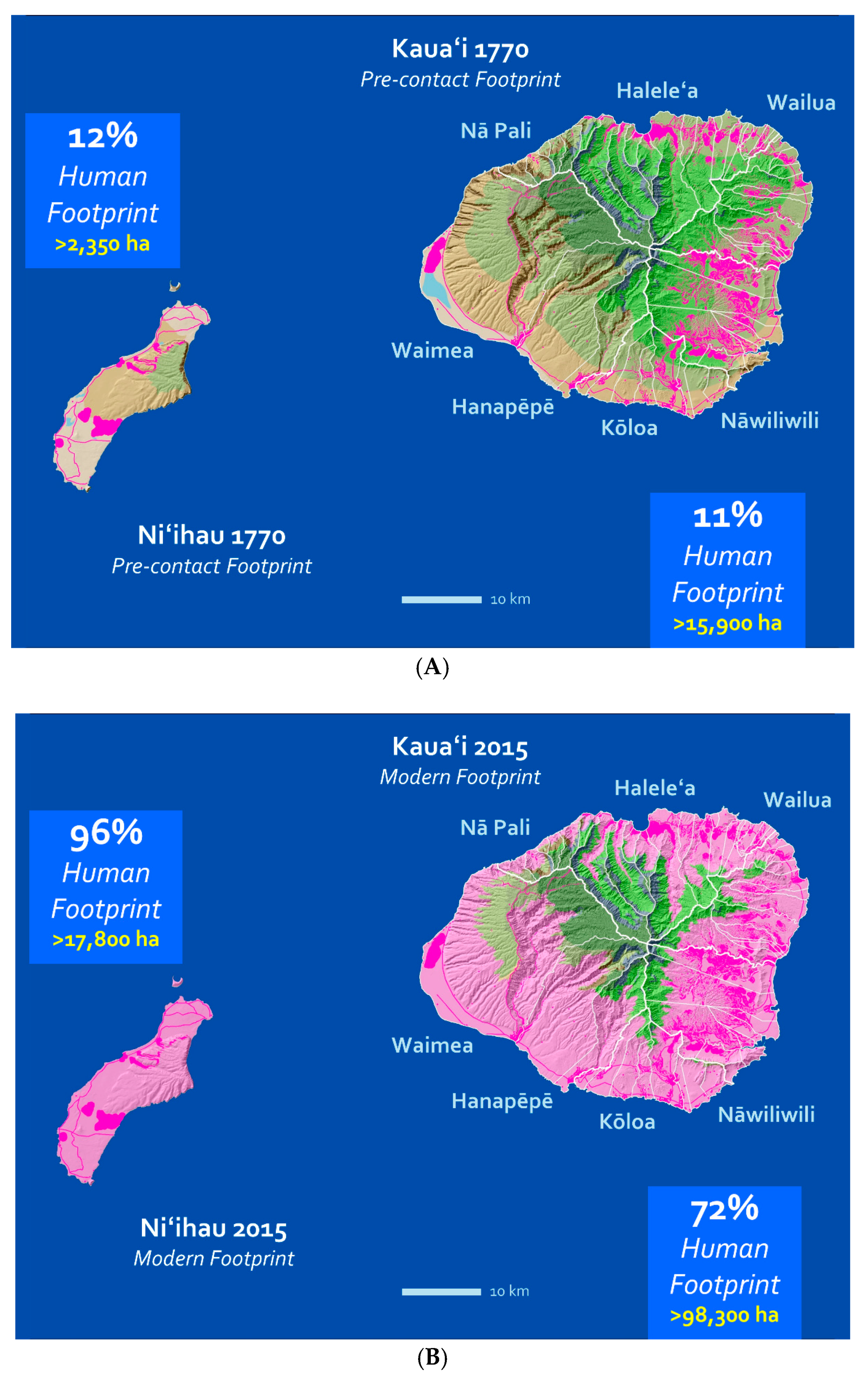
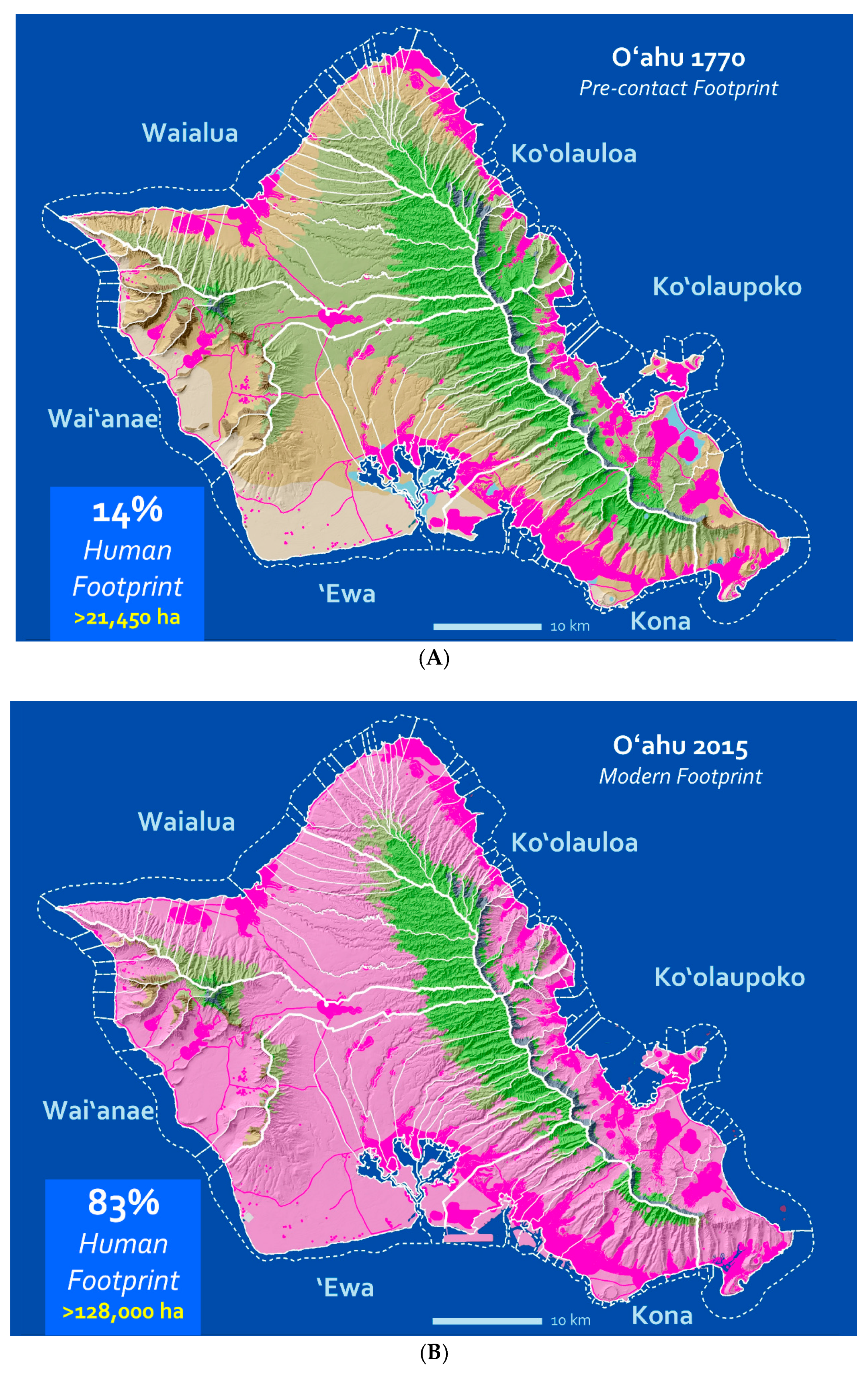
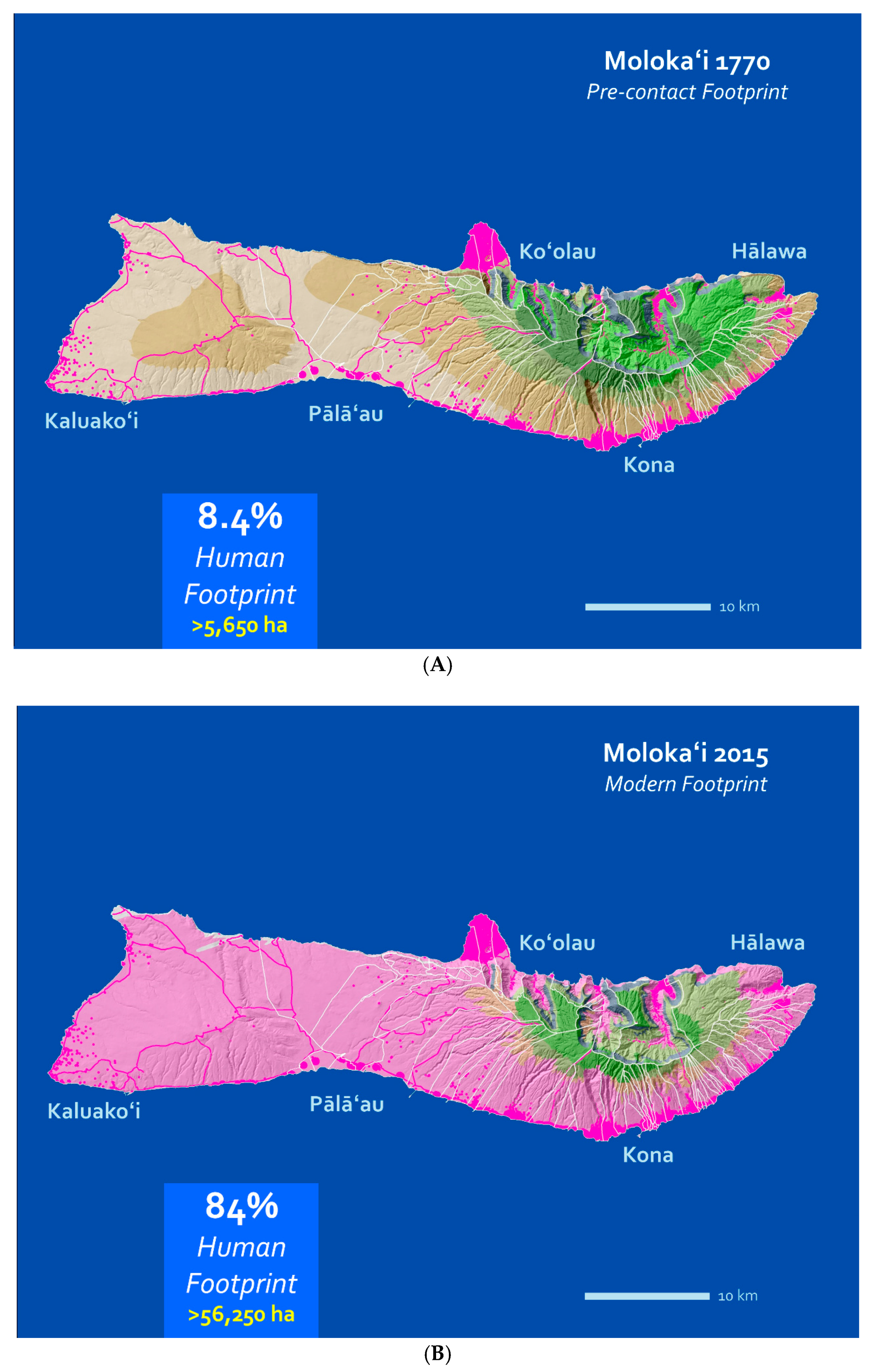

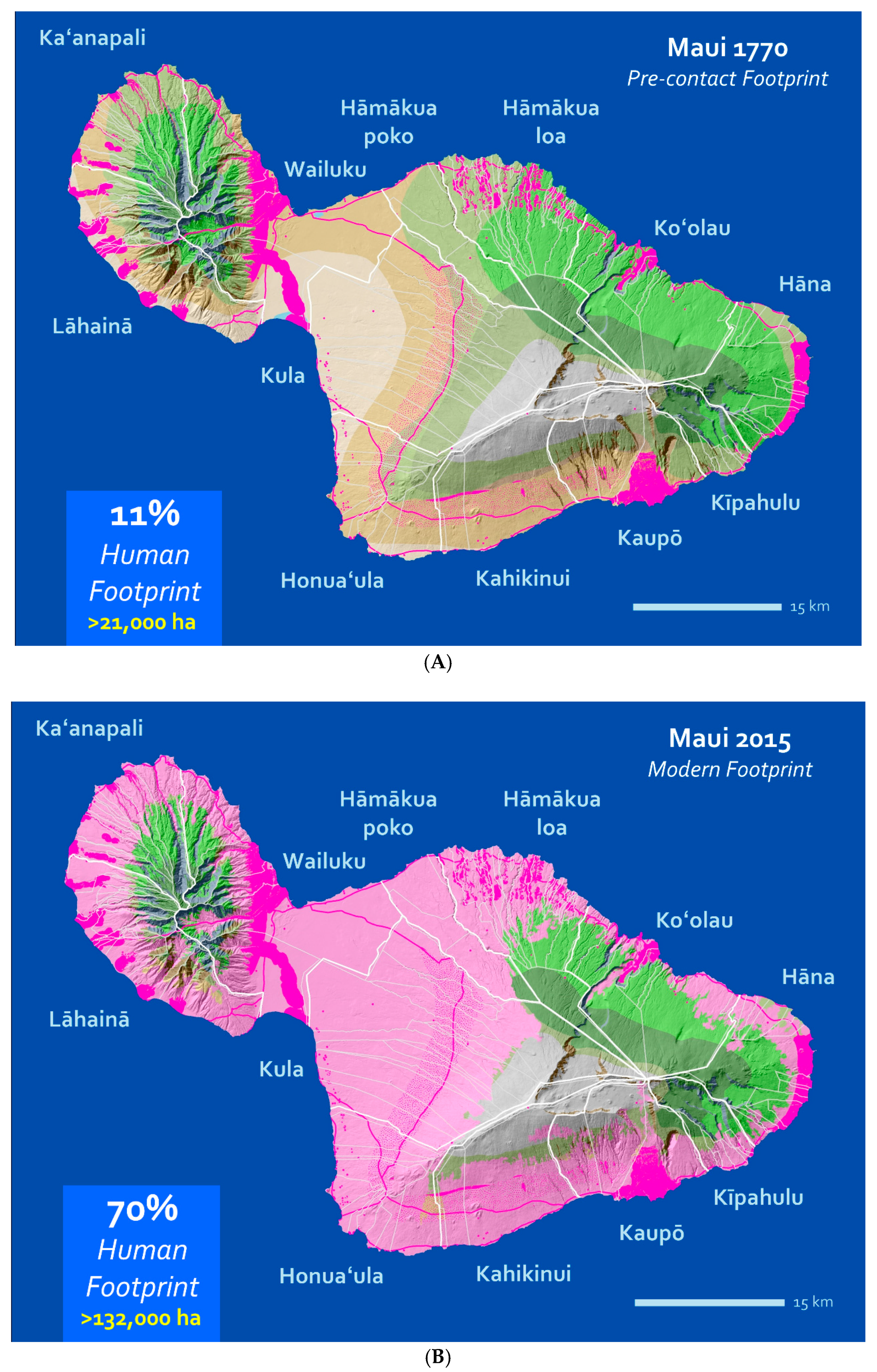
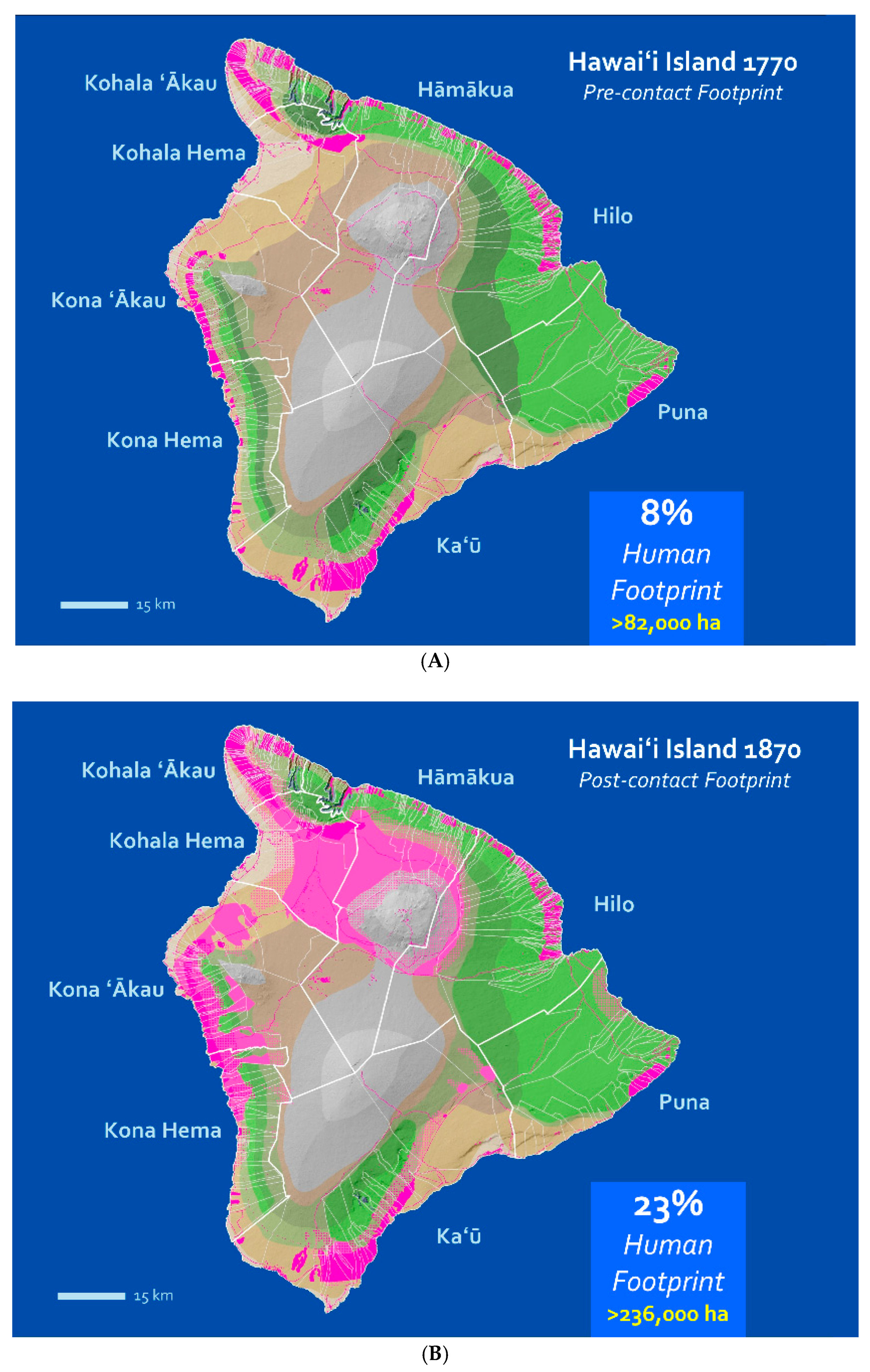
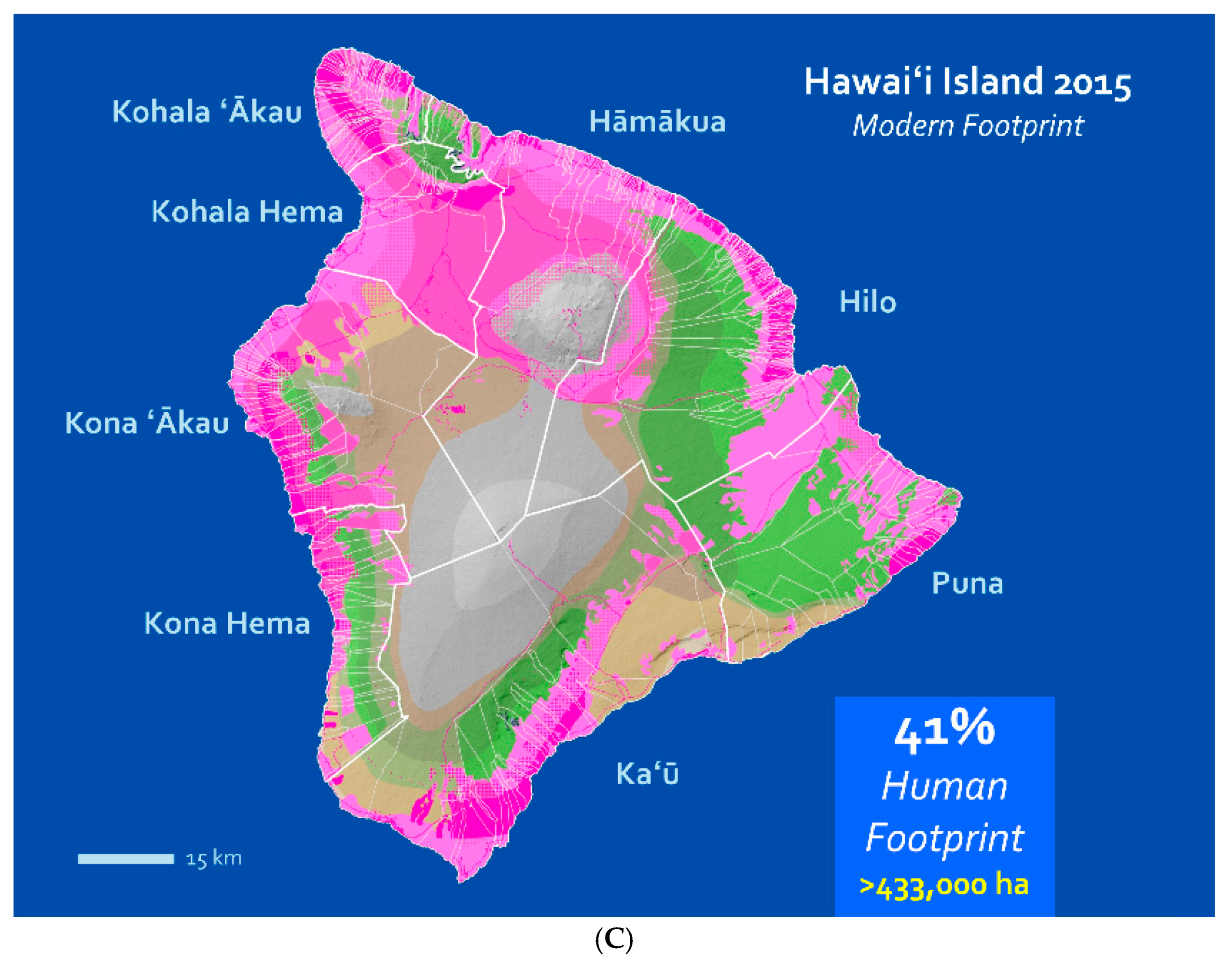

| Native Habitat | Remaining Extent as of 2015 |
|---|---|
| Montane Mesic | 73% |
| Montane Dry | 59% |
| Lowland Wet | 45% |
| Lowland Mesic | 28% |
| Lowland Dry | 30% |
| Native Habitat Loss | 1770 (ha) | % Lost | 1870 (ha) | % Lost | 2015 (ha) | % Lost |
|---|---|---|---|---|---|---|
| Lowland Mesic | 14,400 | 21% | 29,900 | 44% | 48,800 | 72% |
| Lowland Dry | 42,200 | 19% | 93,100 | 43% | 151,300 | 70% |
| Lowland Wet | 20,700 | 9% | 27,500 | 12% | 124,600 | 55% |
| Montane Dry | 2100 | 1.4% | 55,400 | 37% | 61,000 | 41% |
| Montane Mesic | 800 | 1% | 12,900 | 17% | 19,400 | 26% |
| Alpine/Subalpine | 1300 | <1% | 13,600 | 6% | 18,700 | 9% |
| Island | Footprint (Ha) | % | Est. Population |
|---|---|---|---|
| Hawai‘i | 81,800 | 53.0 | 265,000 |
| O‘ahu | 21,600 | 14.0 | 70,000 |
| Maui | 21,100 | 13.6 | 68,000 |
| Kaua‘i | 16,000 | 10.3 | 51,500 |
| Moloka‘i | 5600 | 3.7 | 18,500 |
| Lāna‘i | 5200 | 3.4 | 17,000 |
| Ni‘ihau | 2300 | 1.5 | 7500 |
| Kaho‘olawe | 700 | 0.5 | 2500 |
© 2018 by the authors. Licensee MDPI, Basel, Switzerland. This article is an open access article distributed under the terms and conditions of the Creative Commons Attribution (CC BY) license (http://creativecommons.org/licenses/by/4.0/).
Share and Cite
Gon, S.M.; Tom, S.L.; Woodside, U. ʻĀina Momona, Honua Au Loli—Productive Lands, Changing World: Using the Hawaiian Footprint to Inform Biocultural Restoration and Future Sustainability in Hawai‘i. Sustainability 2018, 10, 3420. https://doi.org/10.3390/su10103420
Gon SM, Tom SL, Woodside U. ʻĀina Momona, Honua Au Loli—Productive Lands, Changing World: Using the Hawaiian Footprint to Inform Biocultural Restoration and Future Sustainability in Hawai‘i. Sustainability. 2018; 10(10):3420. https://doi.org/10.3390/su10103420
Chicago/Turabian StyleGon, Samuel M., Stephanie L. Tom, and Ulalia Woodside. 2018. "ʻĀina Momona, Honua Au Loli—Productive Lands, Changing World: Using the Hawaiian Footprint to Inform Biocultural Restoration and Future Sustainability in Hawai‘i" Sustainability 10, no. 10: 3420. https://doi.org/10.3390/su10103420
APA StyleGon, S. M., Tom, S. L., & Woodside, U. (2018). ʻĀina Momona, Honua Au Loli—Productive Lands, Changing World: Using the Hawaiian Footprint to Inform Biocultural Restoration and Future Sustainability in Hawai‘i. Sustainability, 10(10), 3420. https://doi.org/10.3390/su10103420




